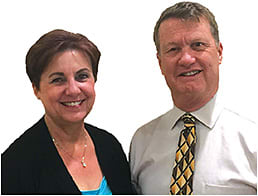
Occupational, workplace, computer, office. Whatever name you want to give to the second-pair eyewear optimized for the viewing distance used during the workday (arm’s length, the computer screen, or the whole office), they are important tools to help alleviate patients’ eye fatigue symptoms—and boost revenue.
Whether it’s occupational PALs that optimize specific working distances in the office or single-vision lenses with a slight accommodative add for computer or reading, these lenses provide the opportunity to serve patients while helping your bottom line.
Just ask Eric White, O.D., of Complete Family Vision Care Optometry in San Diego. Dr. White estimates that his practice brings in $250,000 in profit per year just on sales of occupational and computer/digital eyewear alone.
“This is real money. And my staff isn’t doing a whole lot of extra work,” he says. “And I’m not doing a whole lot of extra work. And my patients are happier.” »
EB sat down with Dr. White and his office administrator/optician (and wife), Lorie White, to share some of the strategies they so successfully employ at their practice.
Tip 1
BE AN INFORMATION CONVEYOR BELT.
The doctors and staff at Complete Family Vision Care Optometry are extremely successful in two cornerstones of optical dispensing: asking the right questions of patients (Desktop? Laptop? Whole office? Tablet?), and passing those visual needs and complaints on to the doctor and then from the doctor back out to the optical staff on the floor.
“Let’s be honest, patients don’t fill out those lifestyle questionnaires completely anyway, so we start talking to them in the pretest area about their chief complaints and how they use their eyes,” Lorie White says.
“And they don’t just stop at ‘do you use a computer?’” adds Dr. White. “I want to prescribe you the exact lenses that will allow you to do comfortably what you need to do all day.”

Tip 2
WALK THE WALK.
If your staff believes in occupational and computer eyewear so much that they wear it themselves, patients are more likely to be receptive to the idea. Lorie White and the rest of the staff can speak personally about how they—with their individual office and computer needs—benefit from the specialty lenses.


Tip 3
KNOWLEDGE IS (SALES) POWER.
Keeping staff up to date on trends and new lens designs doesn’t have to be a chore. Dr. White makes sure to take advantage of every lunch-and-learn session offered by his lens (and frame) vendors.
“I hear so many doctors say they don’t want to lose the staff time. My per-patient revenue is over $600. It’s worth the hour of time to us,” Dr. White says.

Tip 4
LET THE SECRET OUT.
Many patients probably aren’t even aware of what an occupational PAL or SV computer lens can do for their vision and eye fatigue at work. So, tell them—even before they get to the exam room. Dr. White keeps the message active in his practice, with videos about the lenses playing in the waiting room, and plenty of pamphlets and POS materials.

Tip 5
DON’T BE AFRAID OF THE DISCOUNT.
Patients need a little incentive to go for that second pair of eyewear, and sweetening the deal often works. The Whites offer 20% off the second pair and 30% off the third pair purchased.
Because the practice gets a larger multiple-pair discount from the lab, the sale still results in profit.

Dr. White’s success—especially with occupational and computer lenses—comes from a very simple mantra.
“Listen to what the patient needs, prescribe from the chair, and then follow through in the optical,” Dr. White says. “That’s how our office is successful, and that’s how we service our patients’ needs.”




